Abstract
Recently we have shown that active immunization of syngenic animals with anti-ovalbumin antibodies evokes an anti-idiotypic (aId) response, which in consequence leads to suppression of the anti-hapten (benzylpenicilloyl, BPO; dinitrophenyl, DNP) IgE and IgG formation subsequently attempted by immunization with low doses of hapten-OVA conjugates. In this work we describe attempts to suppress a primary or an already established anti-hapten IgE response by passive administration of (anti-carrier) anti-idiotypes to BALB/c mice. Our results show that ongoing anti-BPO or anti-DNP IgE responses can be depressed by injection of (anti-ovalbumin) aId, provided mice were previously immunized with conjugates of the haptens with the ovalbumin (OVA) carrier. The same animals suppressed for IgE also produce less anti-hapten and anti-carrier IgG antibodies but only after 5-6 weeks following the aId injection. The primary IgE response could be blocked by treating mice with (anti-OVA) aId and antigen at the same time.
Full text
PDF
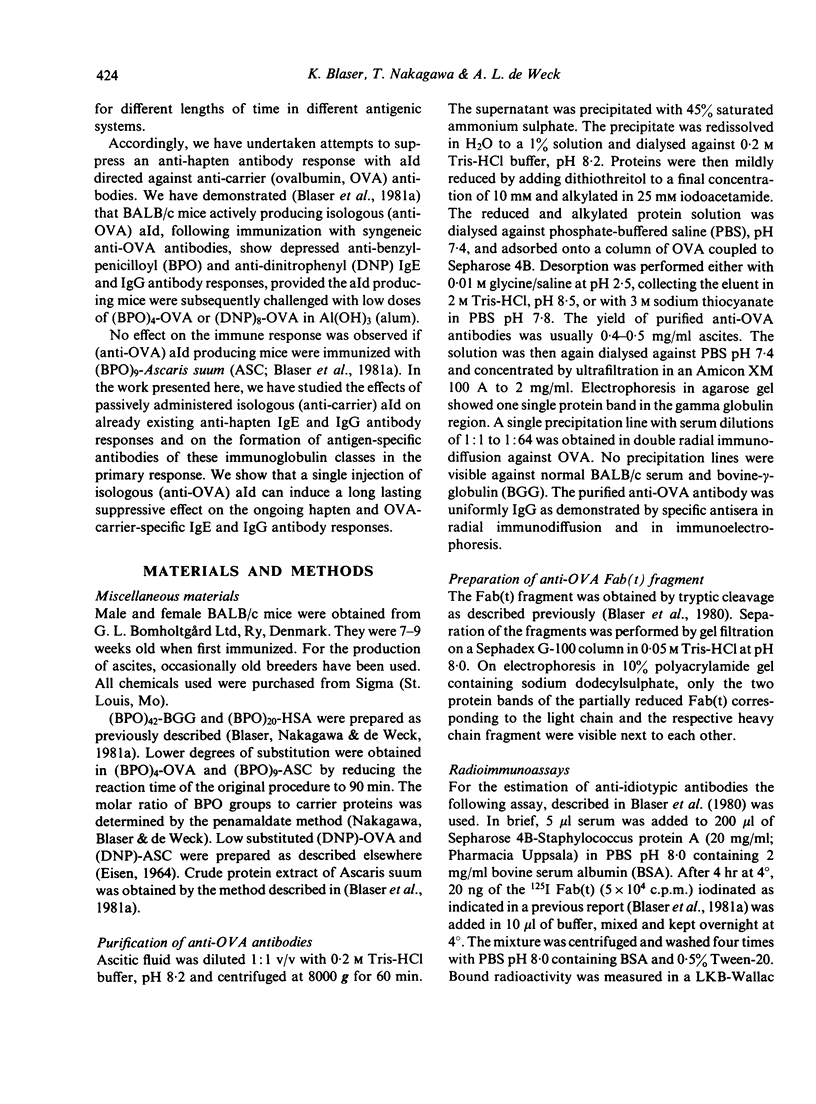
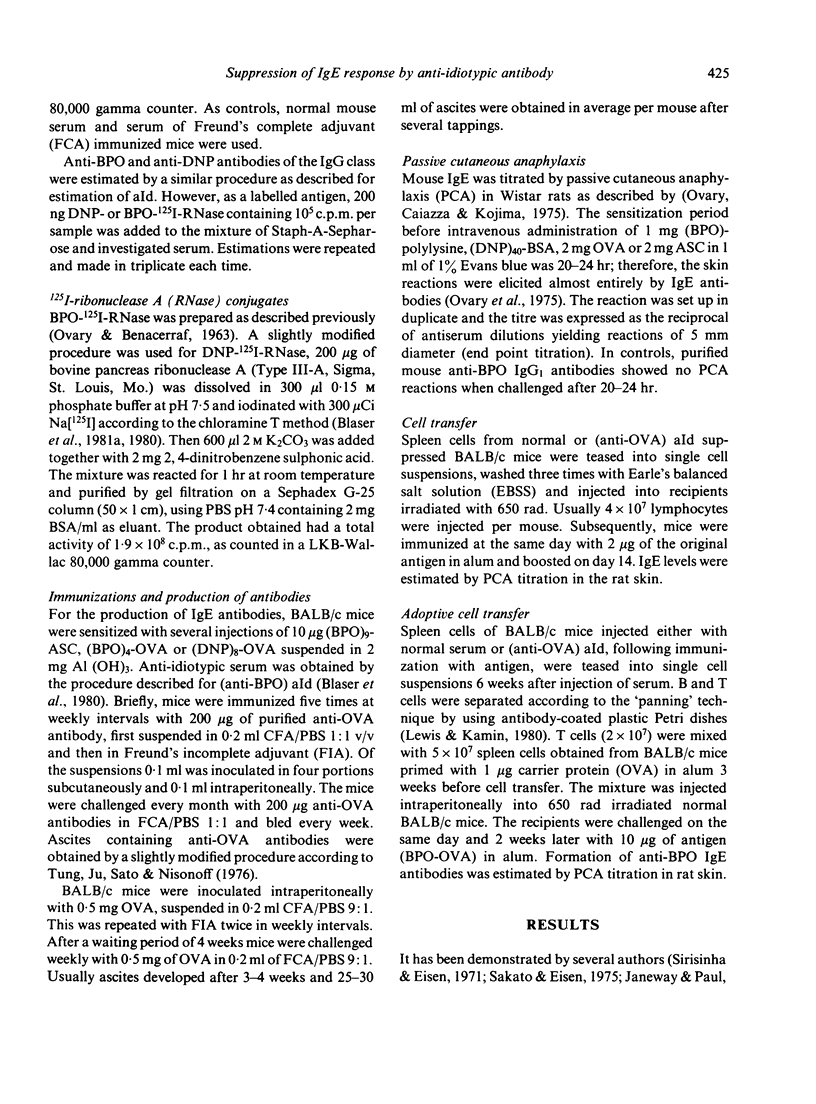
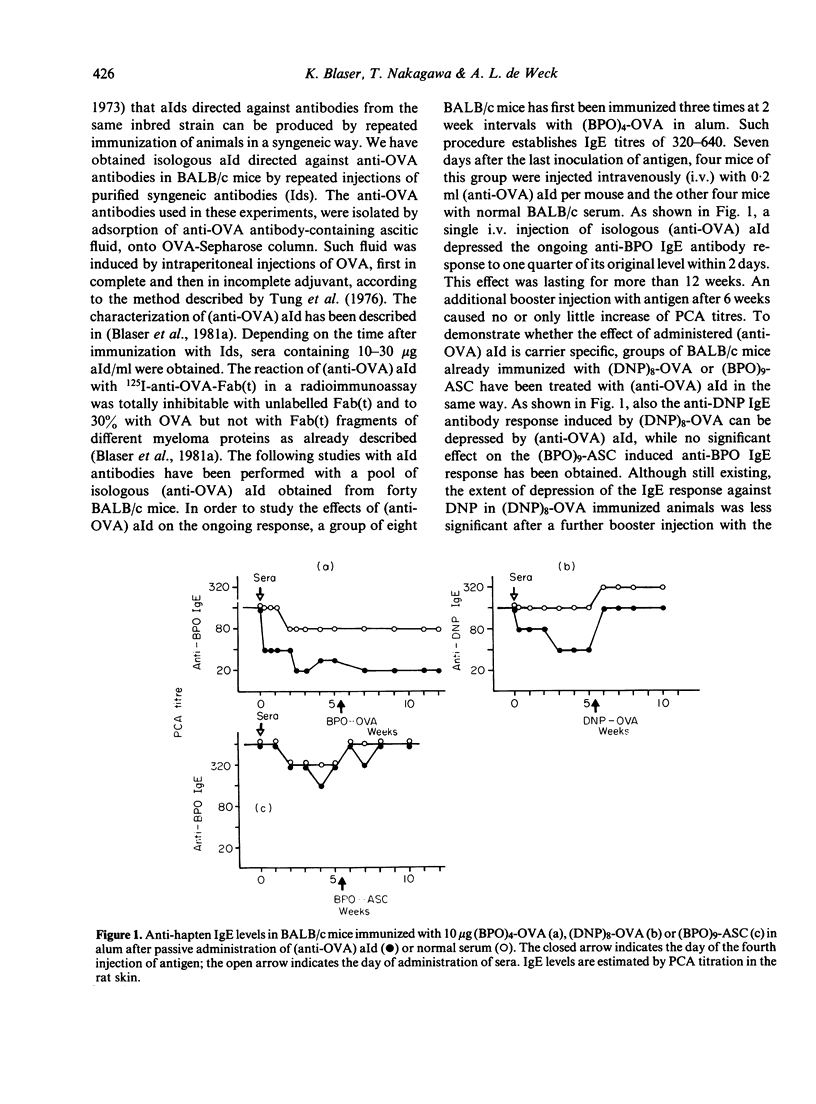
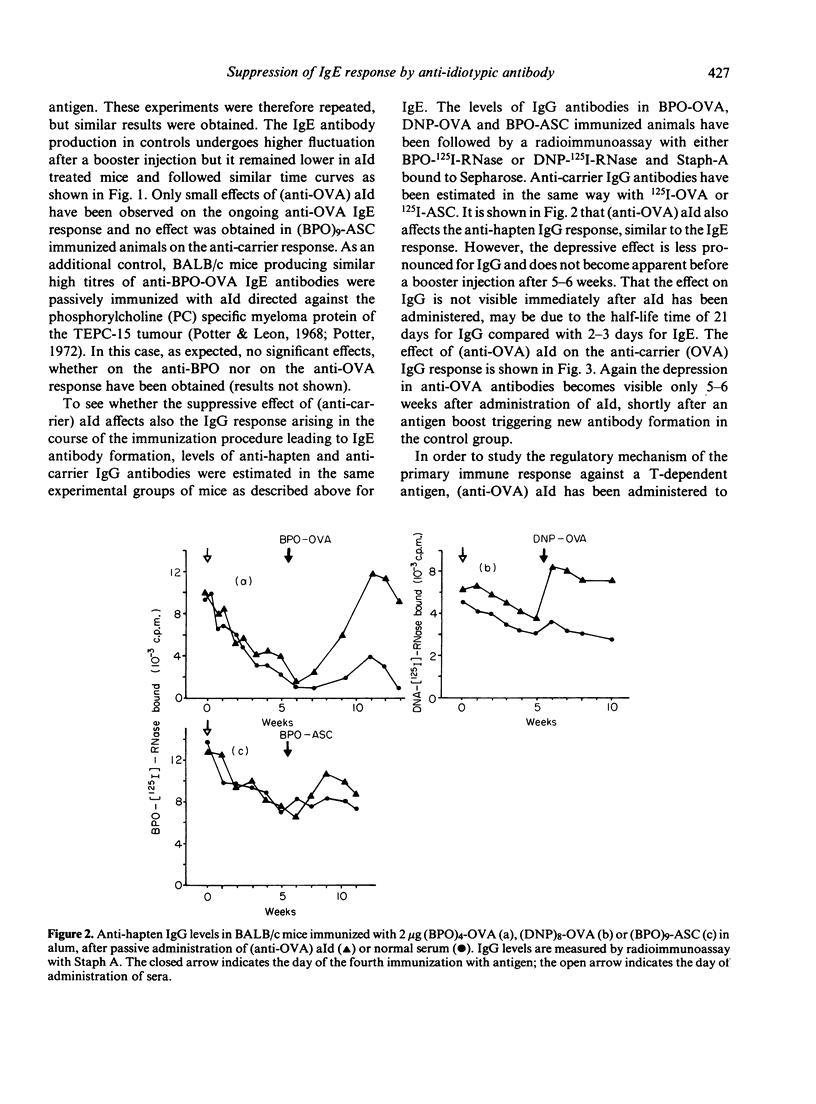
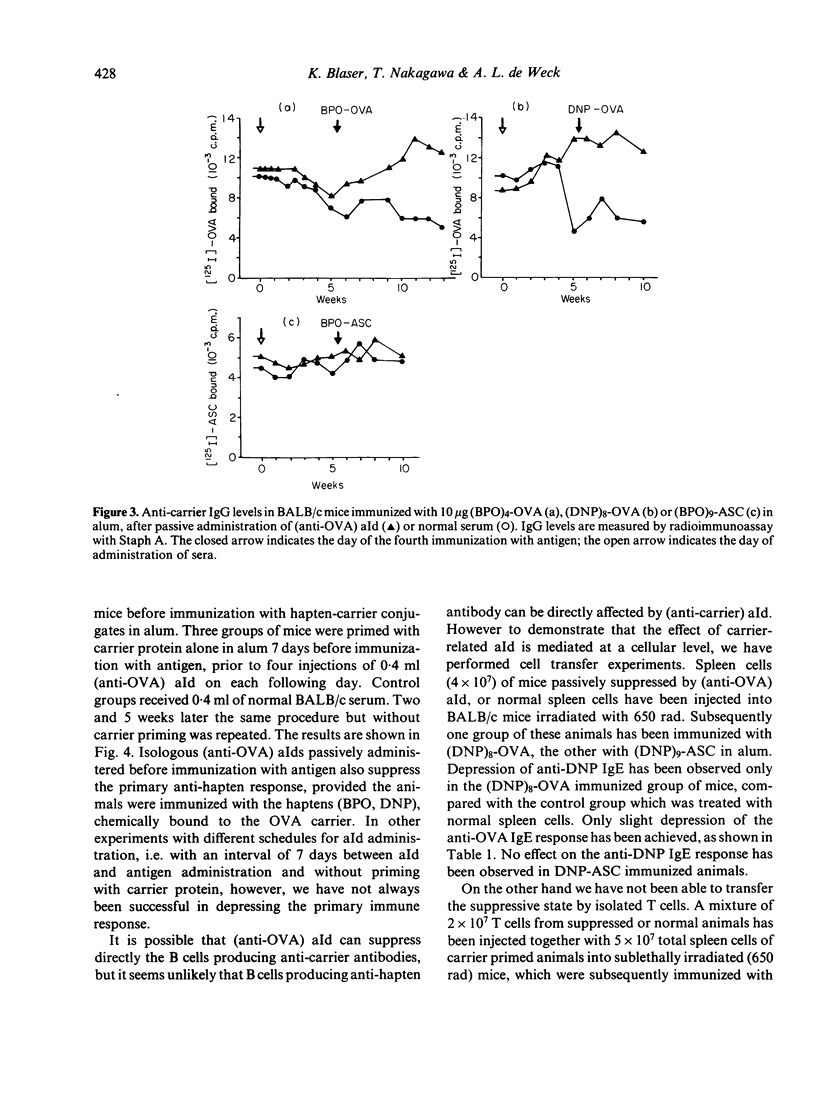
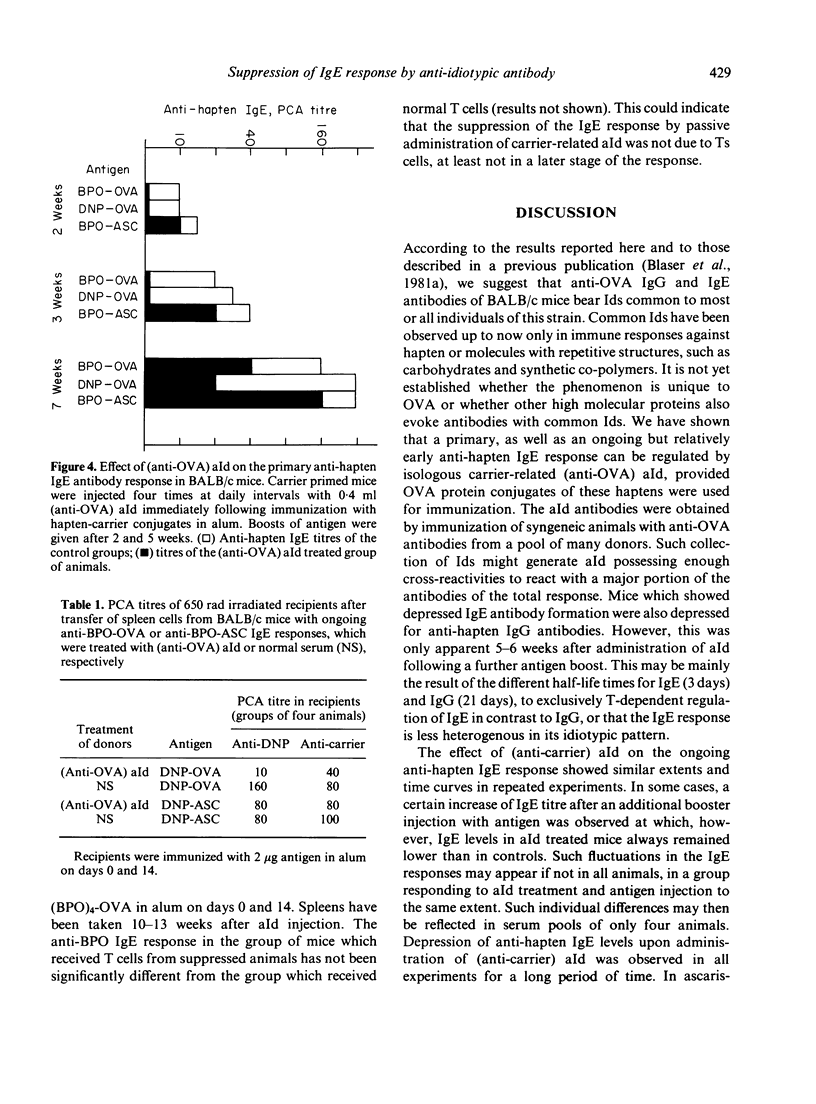
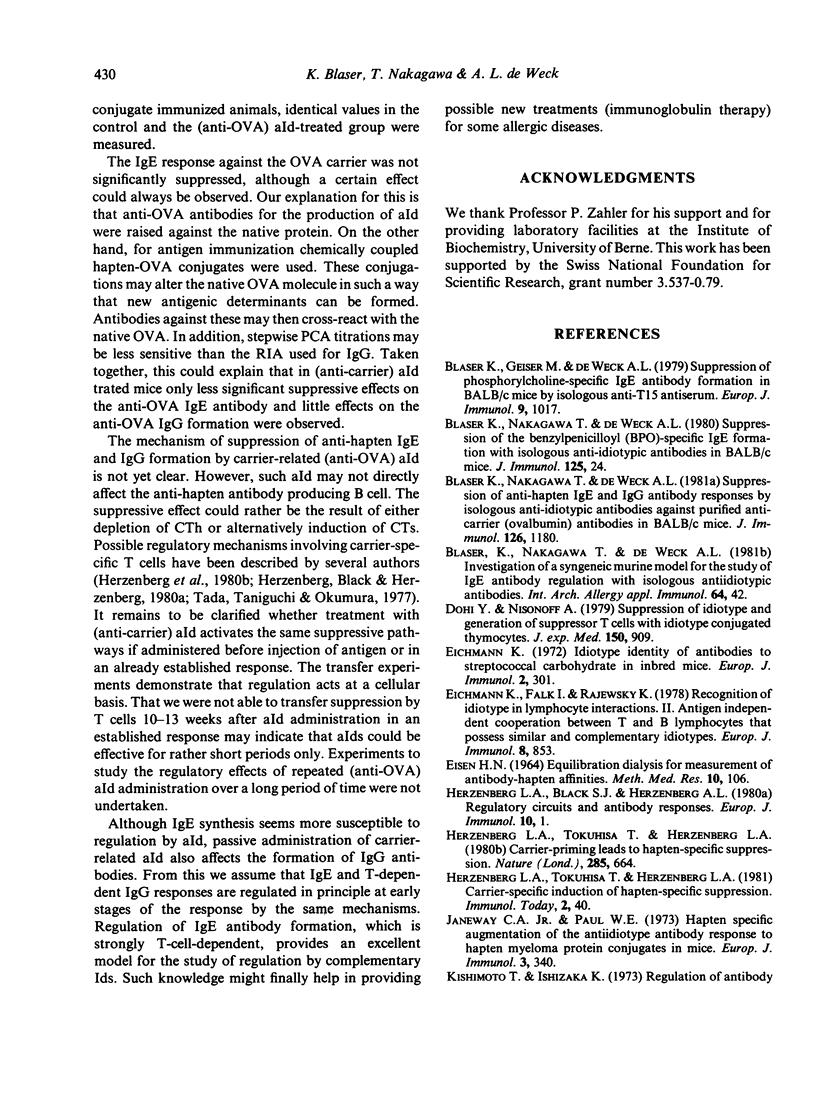
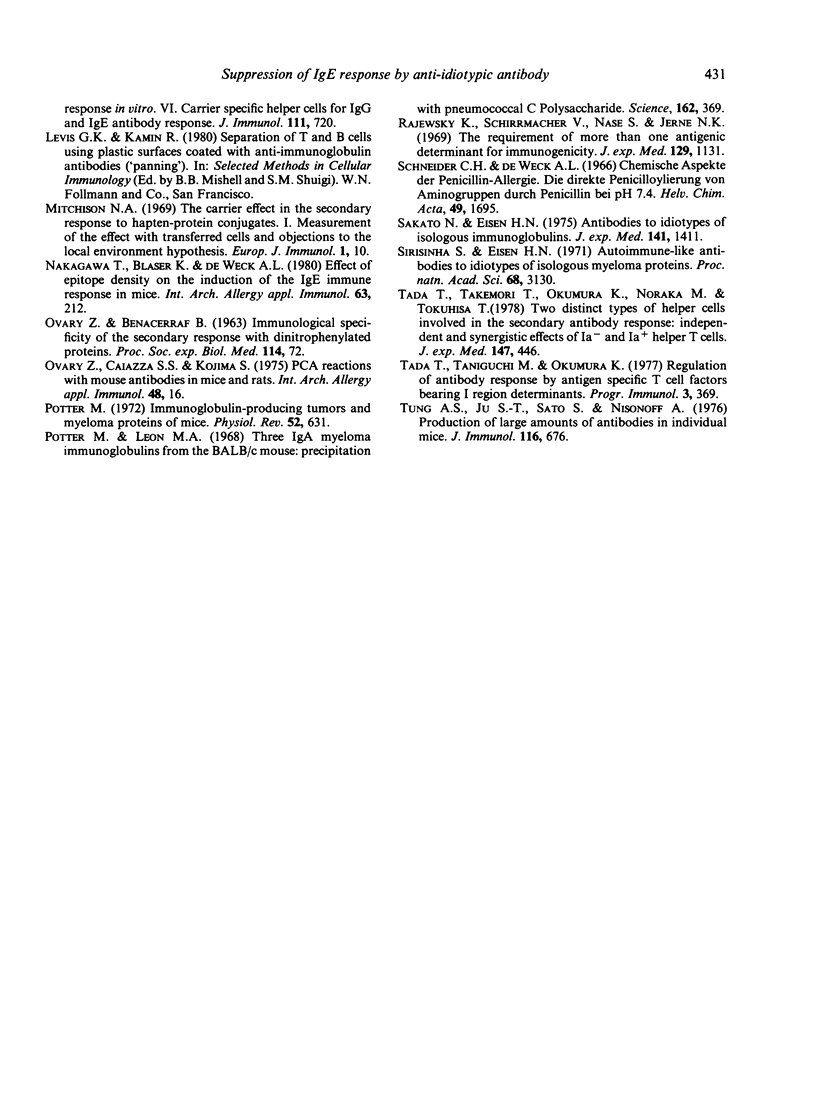
Selected References
These references are in PubMed. This may not be the complete list of references from this article.
- Blaser K., Geiser M., de Weck A. L. Suppression of phosphorylcholine-specific IgE antibody formation in BALB/c mice by isologous anti-T 15 antiserum. Eur J Immunol. 1979 Dec;9(12):1017–1020. doi: 10.1002/eji.1830091218. [DOI] [PubMed] [Google Scholar]
- Blaser K., Nakagawa T., de Weck A. L. Suppression of anti-hapten IgE and IgG antibody responses by isologous anti-idiotypic antibodies against purified anti-carrier (ovalbumin) antibodies in BALB/c mice. J Immunol. 1981 Mar;126(3):1180–1184. [PubMed] [Google Scholar]
- Blaser K., Nakagawa T., de Weck A. L. Suppression of the benzylpenicilloyl- (BPO) specific IgE formation with isologous anti-idiotypic antibodies in BALB/c mice. J Immunol. 1980 Jul;125(1):24–30. [PubMed] [Google Scholar]
- Dohi Y., Nisonoff A. Suppression of idiotype and generation of suppressor T cells with idiotype-conjugated thymocytes. J Exp Med. 1979 Oct 1;150(4):909–918. doi: 10.1084/jem.150.4.909. [DOI] [PMC free article] [PubMed] [Google Scholar]
- EISEN H. N. EQUILIBRIUM DIALYSIS FOR MEASUREMENT OF ANTIBODY-HAPTEN AFFINITIES. Methods Med Res. 1964;10:106–114. [PubMed] [Google Scholar]
- Eichmann K., Falk I., Rajewsky K. Recognition of idiotypes in lymphocyte interactions. II. Antigen-independent cooperation between T and B lymphocytes that possess similar and complementary idiotypes. Eur J Immunol. 1978 Dec;8(12):853–857. doi: 10.1002/eji.1830081206. [DOI] [PubMed] [Google Scholar]
- Eichmann K. Idiotypic identity of antibodies to streptococcal carbohydrate in inbred mice. Eur J Immunol. 1972 Aug;2(4):301–307. doi: 10.1002/eji.1830020402. [DOI] [PubMed] [Google Scholar]
- Herzenberg L. A., Black S. J., Herzenberg L. A. Regulatory circuits and antibody responses. Eur J Immunol. 1980 Jan;10(1):1–11. doi: 10.1002/eji.1830100102. [DOI] [PubMed] [Google Scholar]
- Janeway C. A., Jr, Paul W. E. Hapten-specific augmentation of the anti-idiotype antibody response to hapten-myeloma protein conjugates in mice. Eur J Immunol. 1973 Jun;3(6):340–347. doi: 10.1002/eji.1830030605. [DOI] [PubMed] [Google Scholar]
- Kishimoto T., Ishizaka K. Regulation of antibody response in vitro. VI. Carrier-specific helper cells for IgG and IgE antibody response. J Immunol. 1973 Sep;111(3):720–732. [PubMed] [Google Scholar]
- Mitchison N. A. The carrier effect in the secondary response to hapten-protein conjugates. I. Measurement of the effect with transferred cells and objections to the local environment hypothesis. Eur J Immunol. 1971 Jan;1(1):10–17. doi: 10.1002/eji.1830010103. [DOI] [PubMed] [Google Scholar]
- Nakagawa T., Blaser K., de Weck A. L. Effect of epitope density on the induction of the IgE immune response in mice. Int Arch Allergy Appl Immunol. 1980;63(2):212–219. doi: 10.1159/000232629. [DOI] [PubMed] [Google Scholar]
- OVARY Z., BENACERRAF B. IMMUNOLOGICAL SPECIFICITY OF THE SECONDARY RESPONSE WITH DINITROPHENYLATED PROTEINS. Proc Soc Exp Biol Med. 1963 Oct;114:72–76. doi: 10.3181/00379727-114-28589. [DOI] [PubMed] [Google Scholar]
- Ovary Z., Caiazza S. S., Kojima S. PCA reactions with mouse antibodies in mice and rats. Int Arch Allergy Appl Immunol. 1975;48(1):16–21. doi: 10.1159/000231289. [DOI] [PubMed] [Google Scholar]
- Potter M. Immunoglobulin-producing tumors and myeloma proteins of mice. Physiol Rev. 1972 Jul;52(3):631–719. doi: 10.1152/physrev.1972.52.3.631. [DOI] [PubMed] [Google Scholar]
- Potter M., Leon M. A. Three IgA myeloma immunoglobulins from the BALB/ mouse: precipitation with pneumococcal C polysaccharide. Science. 1968 Oct 18;162(3851):369–371. doi: 10.1126/science.162.3851.369. [DOI] [PubMed] [Google Scholar]
- Rajewsky K., Schirrmacher V., Nase S., Jerne N. K. The requirement of more than one antigenic determinant for immunogenicity. J Exp Med. 1969 Jun 1;129(6):1131–1143. doi: 10.1084/jem.129.6.1131. [DOI] [PMC free article] [PubMed] [Google Scholar]
- Sakato N., Eisen H. N. Antibodies to idiotypes of isologous immunoglobulins. J Exp Med. 1975 Jun 1;141(6):1411–1426. doi: 10.1084/jem.141.6.1411. [DOI] [PMC free article] [PubMed] [Google Scholar]
- Schneider C. H., de Weck A. L. Chemische Aspekte der Penicillin-Allergie: Die direkte Penicilloylierung von epsilon-Aminogruppen durch Penicilline bei pH 7,4. Helv Chim Acta. 1966 Jul 11;49(5):1695–1706. doi: 10.1002/hlca.19660490532. [DOI] [PubMed] [Google Scholar]
- Sirisinha S., Eisen H. N. Autoimmune-like antibodies to the ligand-binding sites of myeloma proteins. Proc Natl Acad Sci U S A. 1971 Dec;68(12):3130–3135. doi: 10.1073/pnas.68.12.3130. [DOI] [PMC free article] [PubMed] [Google Scholar]
- Tada T., Takemori T., Okumura K., Nonaka M., Tokuhisa T. Two distinct types of helper T cells involved in the secondary antibody response: independent and synergistic effects of Ia- and Ia+ helper T cells. J Exp Med. 1978 Feb 1;147(2):446–458. doi: 10.1084/jem.147.2.446. [DOI] [PMC free article] [PubMed] [Google Scholar]
- Tung A. S., Ju S. T., Sato S., Nisonoff A. Production of large amounts of antibodies in individual mice. J Immunol. 1976 Mar;116(3):676–681. [PubMed] [Google Scholar]


